日本福利制度
日本儿童福利政策的特色与发展变革

3、注重信息化服务
随着信息化技术的发展,日本政府将更加注重利用信息技术为儿童提供服务。 未来,政府将加大对儿童福利信息化建设的投入,建立统一的儿童福利信息平台, 实现信息共享和资源整合。这将提高政府的服务效率,更好地满足儿童的需求。
4、应对少子老龄化挑战
面对日益严重的少子老龄化问题,日本政府将加强对老年人和儿童的双重关 爱。政府将加大对老年人照料和支持的投入,同时更加儿童的成长和发展需要。 政府还将推动制定相关政策,鼓励生育和年轻人留居家乡,以应对人口减少带来 的挑战。
2、日本儿童福利制度的发展与 挑战
在随后的几十年中,日本儿童福利制度不断发展,逐渐形成了以《儿童福利 法》为核心的一系列政策和法规。这些政策和法规涉及到儿童养育、教育、医疗、 福利等多个方面,为儿童提供了一个较为全面的福利保障体系。然而,随着社会 变革和人口老龄化的加剧,日本儿童福利制度也面临着诸多挑战。
发展历程
1、日本儿童福利制度的建立
日本儿童福利制度的建立可以追溯到20世纪初。当时,由于社会经济的快速 发展,社会问题和矛盾逐渐凸显,儿童的生存和发展环境也受到严重威胁。为了 应对这一问题,日本政府开始着手建立儿童福利制度。1911年,日本政府颁布了 《儿童福利法》,标志着日本儿童福利制度的确立。
在这一阶段,日本政府开始对儿童福利政策进行全面评估和改革。政府开始 重视家庭和社区在儿童成长中的作用,并通过立法明确了各个部门在儿童福利中 的职责。同时,政府开始加大对早期教育和婴幼儿保育的投入,并针对不同年龄 段的儿童提供个性化的福利服务。此外,政府还通过制定《反对虐待儿童法》等 法律,加强了对儿童的保护。
(3)健康保险。所有儿童都必须参加健康保险,以降低因病致贫的风险。
(4)家庭援助。为有儿童的家庭提供一定的生活补贴和育儿假,以及心理 咨询和支持服务。
日本松下员工福利待遇管理制度
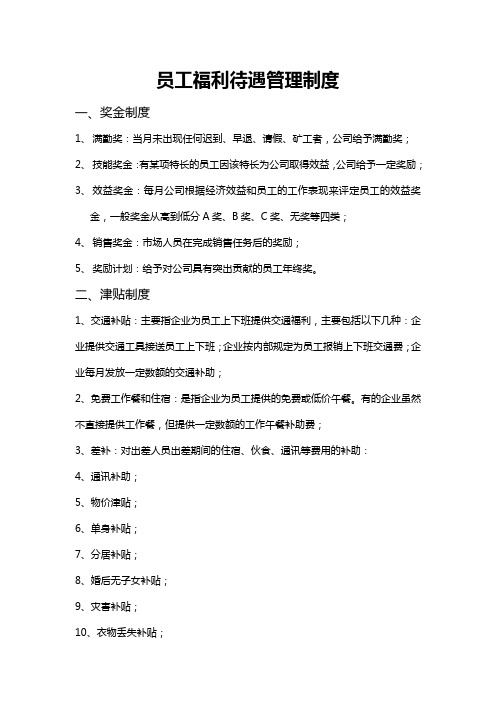
员工福利待遇管理制度一、奖金制度1、满勤奖:当月未出现任何迟到、早退、请假、矿工者,公司给予满勤奖;2、技能奖金:有某项特长的员工因该特长为公司取得效益,公司给予一定奖励;3、效益奖金:每月公司根据经济效益和员工的工作表现来评定员工的效益奖金,一般奖金从高到低分A奖、B奖、C奖、无奖等四类;4、销售奖金:市场人员在完成销售任务后的奖励;5、奖励计划:给予对公司具有突出贡献的员工年终奖。
二、津贴制度1、交通补贴:主要指企业为员工上下班提供交通福利,主要包括以下几种:企业提供交通工具接送员工上下班;企业按内部规定为员工报销上下班交通费;企业每月发放一定数额的交通补助;2、免费工作餐和住宿:是指企业为员工提供的免费或低价午餐。
有的企业虽然不直接提供工作餐,但提供一定数额的工作午餐补助费;3、差补:对出差人员出差期间的住宿、伙食、通讯等费用的补助:4、通讯补助;5、物价津贴;6、单身补贴;7、分居补贴;8、婚后无子女补贴;9、灾害补贴;10、衣物丢失补贴;11、职工防暑降温补贴;12、为职工卫生保健、生活等发放或支付的各项现金补贴和非货币性福利;13、退休补助。
三、有偿假期1、婚假:假3天,符合晚婚条件者(男满二十五周岁,女满二十三周岁),可享有新婚假十天;2、产假:女员工产假90天,刨妇产女员工产假105天,男员工护产假7天,基本工资照发;3、探亲假:未婚员工父母家住外地或夫妻两地分居员工,每年享受一次探亲假,假期20天(包括往返路程),基本工资照发,并报销普通硬座车(船)票;4、丧假:员工直系亲属(父母、配偶、子女)亡故,丧假三天,基本工资照发;5、病假:员工因病请假休息上交正式医院病假证明,包括急症证明,无病假证明的按事假处理。
员工当月因病缺勤时公司仍支付半天工资,病假七天以上(不含七天)按事假计算;6工伤假:员工当班时间,在工作过程中由于突发事件(客观因素而非工作失误)造成的因工负伤,视为工伤。
日本职工的工资与福利

日本职工的工资与福利职工的待遇大致可以分为现金收入、福利保险和休假三种。
现金收入,包括工资和奖金。
日本公司大多采取支付月工资及年中(6月)、年末(12月)两次支付奖金的形式来保证员工的收入。
工资的金额因行业、年龄、学历、经验的有无和长短等因素而异。
一般而言,在日本社会,工资的高低是随着年龄的增长而递增的,在公司里的地位也随着工龄的增加而上升。
在日本这种工资制度被称为“年功序列”。
随着日本“泡沫经济”的破裂,这一工资制度在逐渐改变。
特别是在那些重视能力的高科技行业以及外资企业中,高能高薪的现象越来越普遍。
至于奖金,这没有一个定值,各公司视收益情况而定,但一般来说年中及年末各为平均年收入的 1.5~2.5倍左右的公司、企业较多。
比较正规的公司、企业一般除工资、奖金外,还支付给员工住房补贴、家属补贴、加班费、差旅费等。
日本的公司、企业,为了保证就业人员的稳定性,解除他们的后顾之忧,还为员工加入多种保险。
常见的有健康保险、厚生年金保险、雇佣保险和劳动者灾害补偿保险等。
参加健康保险的,职工去医院就诊时,自己负担诊疗费用的10%,而职工的家属可作为被保对象,只需负担诊疗费用的30%。
所谓厚生年金保险,是指职工在超过65岁后至死亡期间,可以领取一定收入的“年金”的保险。
雇佣保险是保证职工在失业时可以领取失业救济金的保险。
而劳动者灾害保险则是指劳动者在工作期间,在工作中及上下班途中发生的疾病及伤害事故时,可以从保险公司领取保险金的保险制度。
在这些保险中除了劳动者灾害补偿保险是由公司、企业全额支付保险费外,其余的保险基本上是由公司、企业和职工分担支付保险费的。
日本《劳动基准法》第24条,对公司、企业支付职工工资还专门规定了5条基本原则,这5条基本原则的大致内容是:(1)现金支付。
工资只能用现金支付,即使是支票等有价证券也不被允许,因为支票要变成现金需要时间,甚至可能产生不能承兑的风险。
至于用实物来充抵工资则更不被认可。
日本老年福利保障研究及启示

日本老年福利保障研究及启示【摘要】日本是一个老龄化程度很高的国家,其老年福利保障政策备受瞩目。
本文通过对日本老年福利保障政策的历史回顾、制度特点分析、实施效果评估以及对社会发展和其他国家的借鉴意义进行研究,总结出了一些启示。
日本的老年福利保障政策在确保老年人基本生活水平的也促进了社会经济的发展。
其他国家可以借鉴日本的经验,建立更加完善的老年福利体系,以应对老龄化社会带来的挑战。
通过对日本的研究,我们可以得到一些建议和启示,为全球老龄化社会的发展提供借鉴和指导。
【关键词】日本、老年、福利保障、研究、政策、历史、特点、分析、实施效果、评估、社会发展、启示、借鉴意义、总结1. 引言1.1 日本老年福利保障研究及启示概述日本老年福利保障是日本社会保障体系中的一个重要组成部分,旨在保障老年人的基本生活需求和尊严。
随着日本人口老龄化的加剧,老年福利保障政策也逐渐成为社会关注的焦点。
对于日本老年福利保障政策的研究不仅有利于深入了解日本社会的养老保障体系,还可以为其他国家提供借鉴和启示。
通过对日本老年福利保障政策的历史回顾和制度特点分析,可以发现日本在老年福利保障方面的政策经验和做法,深化对老年福利保障问题的认识。
通过对日本老年福利保障政策实施效果的评估,可以了解政策的实际效果和存在的问题,进一步完善老年福利保障制度。
研究日本老年福利保障对社会发展的启示,可以为其他国家制定和完善老年福利保障政策提供参考和借鉴。
对于推动全球老年福利保障事业的发展具有积极的意义和价值。
2. 正文2.1 日本老年福利保障政策历史回顾在日本,老年福利保障政策的历史可以追溯到20世纪初。
最早的老年保障措施可以追溯到第二次世界大战前夕,当时的日本政府开始实施一些福利措施,但覆盖范围很有限。
战后,随着经济的快速发展和人口老龄化问题的凸显,日本政府逐步加大了对老年福利保障政策的投入。
1950年代,日本开始制定一系列老年福利法律,如1961年颁布的《老年人福祉法》和1982年颁布的《老年人福祉基本法》等。
日本移民社会福利制度

日本移民社会福利制度一、儿童保育福利1、子女抚养费由于日本的国情是人口下降趋势,政府强烈鼓励每个人都要孩子。
事实上,只要你怀孕4个月以上,你就可以获得42万日元(约2.5万元人民币)的生育和流产补贴。
可以直接接受现金,也可以直接从住院费用中扣除等。
参与者:所有居民怀孕超过4个月。
此后,政府还将按月向0至15岁的儿童支付津贴,具体如下:0至3岁:每人15,000日元;3岁至小学毕业:第一个孩子10,000日元,第二个孩子10,000日元,第三个孩子(或以上)15,000日元;10,000日元用于小学毕业至15岁:所有医疗费用将部分由当地政府承担,直到孩子满6岁,具体比例因地点而异。
一般来说,生活在日本的孩子不必担心没有钱学习或看医生。
注:日本的生育福利适用于居住在日本(持有固定或永久居留签证)并加入健康保险协会的外国人。
2、产妇津贴福利措施相对较好的公司可以获得正常工资,即使他们休产假。
但是如果公司不支付这笔钱,政府将提供补贴。
补贴金额根据休息时间计算。
如果你休假98天,你每天将得到8000日元(480元人民币),总共三个月的时间里将得到超过520000日元(约30000元人民币)。
当公司给予的补贴少于这个数额时,政府将弥补不足的数额。
对象:公司不支付工资或产假期间日工资低于8000日元的居民。
3、单亲家庭津贴对于单亲家庭,政府每月补贴高达4万日元(2400元人民币),直到孩子满18岁。
二、教育福利大学为大学生提供国家奖学金、地方政府奖学金、企业奖学金和银行提供的无息学生贷款。
也有针对外国学生的官方G30计划奖学金:东京大学、京都大学、名古屋大学、大阪大学等世界一流大学积极聘用大量外国教授,以促进日本大学的国际化,分配海外经验丰富的教师,并鼓励具有多语言背景的外国高中生优先录取并申请奖学金。
三、医疗福利自1961年《医疗保险法》实施以来,日本的全民医疗保险覆盖率已达99%,居世界之首。
《医疗保险法》要求公平地向所有公民提供医疗服务,包括有资格居留的外国人。
2024年日本的薪酬管理制度

3、员工办理停薪留职手续后,公司无义务为其保留原职位,停薪留职员工办理复职手续时,公司按实际工作需要安排相关职位。
第五条、员工在停薪留职期间,根据公司规定,需要签约《员工停薪留职协议书》(详见附表3)。
第六条、员工在停薪留职期间擅自从事与公司同行业同类工作岗位者,一经核实,视其已离职;凡停薪留职满一个月之内不能上班者,视其已离职。
第七条、交接工作手续办理及复职管理
1、停薪留职人员的离职交接手续及工资发放等运作程序与离职手续办理程序相同,填写《员工离职交接表》,(详见附表4)按规定进行审批;
2、任职不满一个月者按实际天数进行核定
七、考试奖金:每月进行一次口腔业务与营销服务考试按末位淘汰制度实行,连续三次考试不及格者解聘,第一名或优秀者可以适当奖励部分现金
八、口腔中心人员凡发生以下情况者,均考虑停发、缓发或减发工资:
1、违反口腔中心政策、规定严重者;
2、辞职或辞退者;
3、以往工作中未发现问题,但对当前中心业绩带来不利影响者;
6.3奖金及提成相关绩效考核说明
6.2.3.1根据各部门工作任务,经营指标,员工职责履行状况,工作绩效考核结果确立。
6.2.3.2绩效考评由公司安排统一进行,与回款收入总额,特殊业绩,贡献相联系。
七、扣除项目
7.1按公司相关处罚条例需要扣除项目。
7.2其它必要扣款。
八、支付方式
现金支付。
九、公司每月支付薪酬日为下月12号。
第八条、公司停薪留职人员待遇
移民日本后可以享受的福利待遇

【导语】在⽇本设⽴公司仅需500万⽇元注册资⾦,每年营业收⼊不低于360万⽇元,但是资⾦归属公司,可以⾃由⽀配运作。
⽽且⽇本离中国距离近、⽅便打理国内外⽣意,所以也吸引了很多⼈前去移民。
以下是整理的移民⽇本后可以享受的福利待遇,欢迎阅读!【篇⼀】移民⽇本后可以享受的福利待遇 1.医疗⽅⾯ ⽇本的医疗⽔平在世界属于地位,在医疗服务和医药费⽤担负⽅⾯依然处于世界地位。
⽇本实⾏全民医保,所以只要你在⽇本拥有永居资格,就需要加⼊国民健康保险,并且国民健康保险针对留学⽣和低收⼊群体会⼤幅减免费⽤。
这个保险所带来的是你在⽇本治病的费⽤,政府承担70-80%,如果是⼤病,⾃⼰承担的医药费也设定了封顶值,超过这个数值就会由政府全部出资,所以⽇本不会出现因治病倾家荡产的情况,并且⽇本医院更是尽职尽责,没有并有没钱得不到救治的现象出现。
2.⼯作⽅⾯ ⽇本⼈“⼯作狂”的绰号也是全球⽂明的,⽇本的企业针对这种情况制订了相应的政策。
针对员⼯对⼯作的积极性,⽇本企业⼀般会在员⼯的薪酬之外⽀付给员⼯相应的福利,⽐如住房补贴、单⾝宿舍甚⾄提供公司住房为员⼯整个家庭解决居住问题。
企业还会为员⼯缴纳厚⽣年⾦、企业年⾦、健康保险,雇佣保险等保障,⽇本企业对于员⼯健康也⾮常重视,为员⼯提供定期的体检以及健⾝,有些⼤企业甚⾄有⾃⼰的幼⼉园。
可以说,⽇本的企业在努⼒为员⼯营造⼀种家庭的感觉。
⽇本企业对于员⼯个⼈能⼒提升同样重视。
他们会为员⼯提供相应的培训。
不同于我们国内很多公司只是简单培训⼀下职业⼼态的课程,⽇本企业的培训更注重员⼯个⼈能⼒的提升,对于表现优秀的员⼯,提供国际进修的机会,更是有⽆限⼤的可能。
每个国家都不能避免有⼈失业的情况出现,⽇本政府针对失业的补救措施也很完善。
⽆论这个⼈是主动辞职还是被公司辞退,都可以拿到相应的补助,同时如果失业的⼈再次找到⼯作,政府还会发放奖励⾦,找到⼯作越快,奖励⾦也会越多。
对于那些暂时找不到⼯作的⼈,政府还会提供学习班为他们进⾏职业培训。
日本的退休金制度

日本的退休金制度日本的退休金制度是日本政府设立的一项保障老年人生活的制度,旨在为退休人员提供稳定的养老金收入。
本文将分析日本退休金制度的基本特点、运作机制以及面临的挑战。
一、基本特点日本的退休金制度可以分为两个层面:国民年金制度和厚生年金制度。
国民年金制度适用于未加入其他年金制度的人群,包括自雇人员、无业人员等。
厚生年金制度适用于公司职员及一些特定职业人员。
1. 国民年金制度国民年金制度是日本政府推行的一种普惠性养老金制度,每个居民(20岁以上)都需要参加并缴纳年金费用。
费用根据个人收入和缴费年限而定,一般为月缴费16,560日元(约合150美元)。
国民年金制度的特点在于其普遍性,无工作的人员也需要缴纳,以确保每个人都能享受到一定的养老金待遇。
2. 厚生年金制度厚生年金制度是日本企业职员的养老金制度,覆盖了绝大部分的公司员工。
员工和雇主共同缴纳年金费用,费用根据个人收入计算,一般为月缴费基数的18.3%。
厚生年金制度的特点在于其稳定性和可持续性,由于员工和雇主共同分担费用,相对于国民年金制度而言,待遇水平较高。
二、运作机制日本的退休金制度采用分级运作的方式,由国家与地方政府、厂商等合作实施。
1. 政府管理退休金制度由日本厚生劳动省管理,负责收取缴费、核算年金、发放养老金等工作。
政府还设立了日本年金机构,专门负责管理年金的收支和养老金的发放。
2. 地方合作日本的地方政府也发挥了重要作用,负责年金的征收和管理工作。
地方政府与厚生劳动省合作,确保年金的正常运作。
3. 公司参与在厚生年金制度中,公司扮演着重要角色。
公司不仅需要按照法定比例与员工共同缴纳年金费用,还需要定期向养老金机构报告员工工资和缴费情况。
三、面临的挑战日本的退休金制度面临着许多挑战,包括少子化、人口老龄化以及经济不稳定等问题。
1. 少子化日本面临严重的少子化问题,劳动力人口减少导致缴费人数减少,增加了养老金负担。
2. 人口老龄化由于日本人口老龄化的速度快于其他国家,退休人员数量增加,增加了养老金支付的金额。
日本的社会保障制度

日本的社会保障制度日本的社会保障制度是指由日本政府提供的各种社会福利措施,旨在保障日本国民在各个方面的基本权益和生活水平。
该制度基于日本宪法第25条,根据平等和公正的原则,通过法律和政策来为弱势群体提供帮助和支持。
首先,日本的社会保障制度包括医疗保险、养老保险、失业保险和生育/育儿保险等几个主要方面。
医疗保险是为了确保所有日本居民能够获得基本的医疗保健服务,属于普遍的强制性保险制度。
养老保险则通过社会保险制度,为劳动者提供退休金和养老服务。
失业保险是为了保障失业者的基本生活,提供经济援助和职业培训。
而生育/育儿保险则旨在支持妇女在孕期和分娩后能够顺利工作。
其次,日本的社会保障制度强调普惠性,即对所有的日本国民平等提供社会保障福利。
无论是公务员、私营企业员工、自营业主还是非正式就业人群,都能享受到相同的社会保障待遇。
这种制度设计可以有效防止社会不公平的发生,保证了所有人在面对风险和困难时都能得到相应的援助。
此外,日本的社会保障制度还注重适应经济和社会发展的需求。
例如,医疗保险和养老保险制度不断进行改革和调整,以适应人口老龄化和社会发展的需求。
通过提高养老金的起领年龄、调整医疗费用的支付方式等,保证社会保障制度的可持续性和稳定性。
然而,日本的社会保障制度也存在一些问题和挑战。
首先是长期护理保险制度的不足,随着日本人口老龄化程度的加深,对长期护理服务的需求日益增加,但供给不足。
其次是某些特殊群体的社会保障待遇相对不足,例如低收入家庭、残疾人群体等具有特殊需求的群体。
此外,社会保障制度的成本压力也越来越大,需要政府通过制度改革和财务调整来应对。
总的来说,日本的社会保障制度是一个较为完善的系统,致力于保障国民的基本权益和提高生活水平。
通过普惠性、可持续性和适应性的原则,以及不断进行改革和调整,日本的社会保障制度能够相对有效地应对社会和经济发展的挑战。
日本老年福利保障研究及启示

日本老年福利保障研究及启示一、日本老年福利保障制度的发展历程日本的老年福利保障制度可以追溯到二战后的1951年,当时日本政府为了解决战后老年人的困境,制定了日本的老人福利法。
随着时间的推移,老年福利制度逐渐失去了对老年人的照顾。
直到1989年,日本政府提出了“建立一个全面的老年福利保障制度”的目标,这标志着日本老年福利保障制度进入了一个新的发展阶段。
日本的老年福利保障制度主要包括基本养老保险、高级者医疗保险、长期照护保险以及老人福利设施等方面。
1. 基本养老保险:日本的基本养老保险是一种统筹养老金的制度,所有工作者和雇员都需要参加。
该制度的特点是基于工龄和个人缴纳的养老保险费用来确定养老金的发放额度。
2. 高级者医疗保险:高级者医疗保险是为65岁以上的老年人提供的一种医疗保险。
该保险制度将医疗费用分担给个人和政府,使得老年人可以获得相对廉价的医疗服务。
3. 长期照护保险:长期照护保险是为了应对老年人护理需求而设立的一种保险制度。
根据老年人的护理需求,政府会提供相应的护理服务和经济援助。
4. 老人福利设施:日本的老人福利设施包括老年福利院、独居老人支援中心、老人健康促进中心等,为老年人提供全方位的服务和支持。
日本的老年福利保障制度在其中存在一些值得中国借鉴和研究的方面。
高级者医疗保险制度能够为老年人提供相对廉价的医疗服务,为他们解决医疗费用的问题。
中国应该通过建立老年人医疗保险制度,为老年人提供相对廉价的医疗服务,减轻他们的经济负担。
老年福利设施的建设也是中国可以学习的经验。
中国需要建立更多的老年福利设施,为老年人提供安全舒适的居住环境和全方位的服务。
日本的老年福利保障制度在发展历程、主要内容以及启示方面都值得中国借鉴和研究。
通过学习日本的经验,中国可以更好地制定和完善老年福利保障制度,为老年人提供更好的养老、医疗和护理服务。
日本国民幸福指数有多高?社会福利大解析!
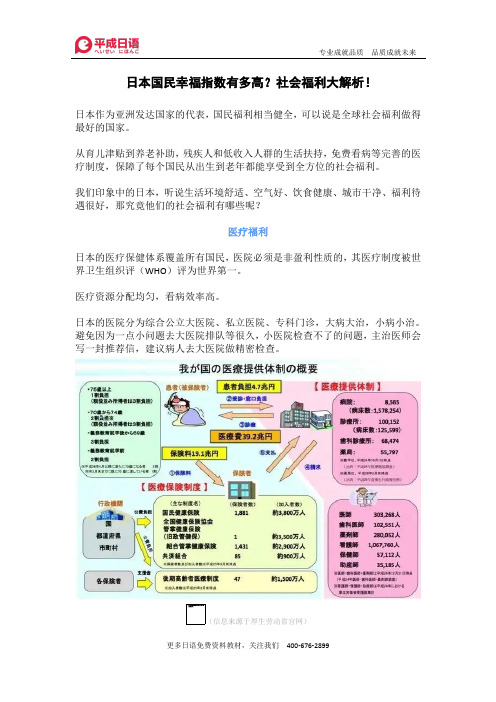
免除了居民税的自宅生平均下来可减免45万日元,自宅外的学生可减免88万日元。
国公立大学对比
从图中可以看出国公立大学最多能减免54万日元,私立大学最多能减免70万日元。
试想一下国内的大学生一年的大学学费加上生活费也不过如此吧。日本政府这补贴力度真的是很给力了!
针对外国人学生还有官方G30计划奖学金:东京大学、京都大学、名古屋大学、大阪大学等世界一流大学。为推进日本大学的国际化而积极聘用大量外籍教授,配置海外经历师资,也促使多语言背景外国人高中生们得到优待入学及申领奖学金的机会。
日本本国国民及在日本长期居住的外国人,只要在这里生活,一生都伴随着各种补助,无论生老病死,人生的重大转折点都有国家在背后给予强大的支持。
作为日本国民还是很幸福的,对于年轻人来说,自己有稳定工作,月光也没关系,总的来说在日本生活的幸福指数还是很高的。
【免责声明】如发现内容存在版权问题,烦请提供信息我们将及时处理。本文相关资料来源于网络。
日本国民幸福指数有多高?社会福利大解析!
日本作为亚洲发达国家的代表,国民福利相当健全,可以说是全球社会福利做得最好的国家。
从育儿津贴到养老补助,残疾人和低收入人群的生活扶持,免费看病等完善的医疗制度,保障了每个国民从出生到老年都能享受到全方位的社会福利。
我们印象中的日本,听说生活环境舒适、空气好、饮食健康、城市干净、福利待遇很好,那究竟他们的社会福利有哪些呢?
医疗福利
日本的医疗保健体系覆盖所有国民,医院必须是非盈利性质的,其医疗制度被世界卫生组织评(WHO)评为世界第一。
医疗资源分配均匀,看病效率高。
日本的医院分为综合公立大医院、私立医院、专科门诊,大病大治,小病小治。避免因为一点小问题去大医院排队等很久,小医院检查不了的问题,主治医师会写一封推荐信,建议病人去大医院做精密检查。
日本社会保障的重点:老人福利

2、资金来源
2、资金来源
日本老人福利的资金主要来源于国家财政和国民缴费。其中,养老金和医疗 保险的费用主要由个人缴纳,而护理保险的费用由国家和个人共同承担。
3、服务质量
3、服务质量
日本老人福利的服务质量较高,主要体现在以下几个方面: (1)服务专业化:日本老人福利的服务人员都经过专业培训,具备较高的专 业素质和服务能力。
内容摘要
综上所述,美国社会保障及残疾人福利虽然存在一些问题,但仍有很大的改 进空间。通过政府和社会的共同努力,我们可以为更多像露西一样的人提供支持 和保障,让他们在面对困难时能够勇敢地迈出一步。对此,我们应该认真思考并 行动起来,为弱势群体提供更多的关爱和帮助。
谢谢观看
1、财政负担
随着人口老龄化问题的加剧,日本老人福利的财政负担越来越重。虽然日本 政府已经加大了对老人福利的投入,但仍面临着资金不足的问题。
2、社会压力
2、社会压力
由于老人福利服务的普及和质量的提高,一些老年人过分依赖福利服务,给 社会带来了压力。此外,一些老年人因为担心成为社会和家庭的负担而产生消极 情绪。
2、提高服务效率
2、提高服务效率
政府应该加大对福利服务的投入,提高服务效率和质量,以满足老年人的需 求。此外,政府还可以通过引入新技术和管理方法来提高服务效率。
3、加强道德教育
3、加强道德教育
政府应该加强道德教育,让老年人明白福利服务的意义和价值,避免过分依 赖和消极情绪的产生。此外,政府还应该鼓励老年人积极参与社会活动,提高他 们的社会地位和价值感。
日本社会保障的重点:老人福 利
01 一、背景介绍
目录
02 二、服务内容
03 三、服务水平
04 四、存在的问题
日本关于婴儿的法律规定(3篇)
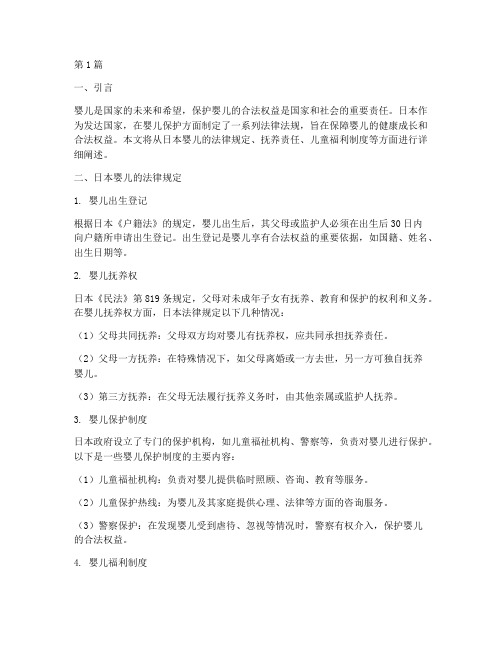
第1篇一、引言婴儿是国家的未来和希望,保护婴儿的合法权益是国家和社会的重要责任。
日本作为发达国家,在婴儿保护方面制定了一系列法律法规,旨在保障婴儿的健康成长和合法权益。
本文将从日本婴儿的法律规定、抚养责任、儿童福利制度等方面进行详细阐述。
二、日本婴儿的法律规定1. 婴儿出生登记根据日本《户籍法》的规定,婴儿出生后,其父母或监护人必须在出生后30日内向户籍所申请出生登记。
出生登记是婴儿享有合法权益的重要依据,如国籍、姓名、出生日期等。
2. 婴儿抚养权日本《民法》第819条规定,父母对未成年子女有抚养、教育和保护的权利和义务。
在婴儿抚养权方面,日本法律规定以下几种情况:(1)父母共同抚养:父母双方均对婴儿有抚养权,应共同承担抚养责任。
(2)父母一方抚养:在特殊情况下,如父母离婚或一方去世,另一方可独自抚养婴儿。
(3)第三方抚养:在父母无法履行抚养义务时,由其他亲属或监护人抚养。
3. 婴儿保护制度日本政府设立了专门的保护机构,如儿童福祉机构、警察等,负责对婴儿进行保护。
以下是一些婴儿保护制度的主要内容:(1)儿童福祉机构:负责对婴儿提供临时照顾、咨询、教育等服务。
(2)儿童保护热线:为婴儿及其家庭提供心理、法律等方面的咨询服务。
(3)警察保护:在发现婴儿受到虐待、忽视等情况时,警察有权介入,保护婴儿的合法权益。
4. 婴儿福利制度日本政府为婴儿及其家庭提供了多项福利政策,以保障其基本生活和发展需求。
以下是一些主要福利政策:(1)育儿津贴:为新生儿及其家庭提供一定数额的津贴,以减轻家庭负担。
(2)育儿休假:母亲在生育后可享受育儿休假,父亲也可申请育儿休假,以照顾婴儿。
(3)儿童医疗保险:为婴儿提供免费或低成本的医疗保险,保障其健康。
(4)儿童保育服务:为有需要的家庭提供儿童保育服务,如托儿所、幼儿园等。
三、抚养责任1. 父母抚养责任日本法律规定,父母对婴儿有抚养、教育和保护的权利和义务。
父母应尽到抚养责任,包括提供生活必需品、保障婴儿身心健康、教育引导等。
日本退休金制度
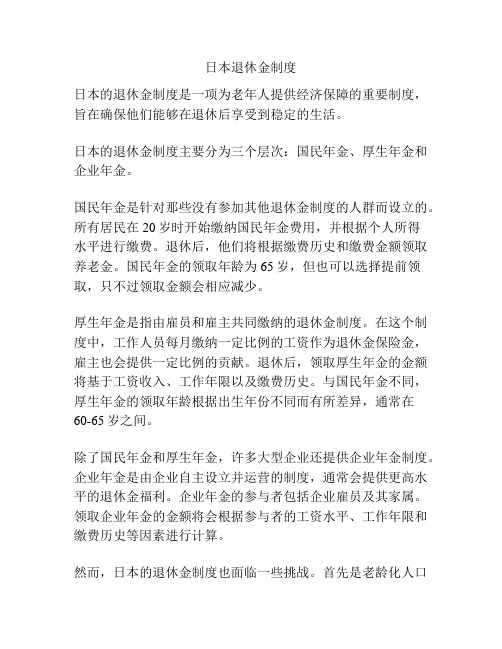
日本退休金制度日本的退休金制度是一项为老年人提供经济保障的重要制度,旨在确保他们能够在退休后享受到稳定的生活。
日本的退休金制度主要分为三个层次:国民年金、厚生年金和企业年金。
国民年金是针对那些没有参加其他退休金制度的人群而设立的。
所有居民在20岁时开始缴纳国民年金费用,并根据个人所得水平进行缴费。
退休后,他们将根据缴费历史和缴费金额领取养老金。
国民年金的领取年龄为65岁,但也可以选择提前领取,只不过领取金额会相应减少。
厚生年金是指由雇员和雇主共同缴纳的退休金制度。
在这个制度中,工作人员每月缴纳一定比例的工资作为退休金保险金,雇主也会提供一定比例的贡献。
退休后,领取厚生年金的金额将基于工资收入、工作年限以及缴费历史。
与国民年金不同,厚生年金的领取年龄根据出生年份不同而有所差异,通常在60-65岁之间。
除了国民年金和厚生年金,许多大型企业还提供企业年金制度。
企业年金是由企业自主设立并运营的制度,通常会提供更高水平的退休金福利。
企业年金的参与者包括企业雇员及其家属。
领取企业年金的金额将会根据参与者的工资水平、工作年限和缴费历史等因素进行计算。
然而,日本的退休金制度也面临一些挑战。
首先是老龄化人口的增加。
随着人口老龄化的加剧,养老金领取人数的增加将对养老金的支付产生压力。
其次,目前的退休金制度设立时间较早,无法完全适应日益变化的劳动力市场和生活方式。
因此,政府近年来一直在努力进行改革,以提高退休金制度的可持续性和公平性。
总的来说,日本的退休金制度通过国民年金、厚生年金和企业年金的三层次设立,为老年人提供经济保障。
然而,随着人口老龄化的加剧和劳动力市场的变化,退休金制度也需要不断进行改革,以确保其可持续性和公平性。
中国和日本的社会福利制度有何差异?

中国和日本的社会福利制度有何差异?随着现代化的发展,社会福利逐渐成为了重要的议题。
中国和日本作为两个世界上最大的经济体,在社会福利制度方面有哪些差异呢?下面将从以下几个方面逐一进行剖析。
一、养老保险中国和日本在养老保险方面有很大的差异。
在中国,养老保险系统采用了企业单位缴费、国家统筹的方式,分为基本养老保险和个人商业养老保险。
而在日本,养老保险制度通过雇主对雇员的养老金统一管理实现,由日本年金机构进行养老金的支付和管理。
在实际操作中,中国的养老保险制度存在很多问题,如地域和城乡分割、进退两难等问题。
而日本的养老保险制度相对较为完善,但也有着养老金缩减、财政赤字等问题。
二、医疗保险在医疗保险方面,中国和日本有明显的差异。
中国的医疗保险制度为分级别管理,包括基本医疗保险和商业医疗保险。
其中基本医疗保险为政府承担一部分费用,受众较广,但也存在统筹不平、先进制度缺失等问题。
而商业医疗保险则需要个人自费。
日本的医疗保险制度相对完善,包括国民健康保险、企业健康保险和勞动者健康保险等多个类别。
日本的医疗保险制度实现了由政府部门和保险公司共同承担医疗费用的方式,确保了国民医疗保健的权益和社会福利制度的良性循环。
三、教育制度在教育制度方面,中国和日本亦有明显差异。
中国的教育制度以考试为导向,学校和教育机构数量庞大,但存在着教育资源不均、教育投入不足的问题。
而日本的教育制度则注重教育的整体均衡和教育质量的提高。
日本实行免费教育,从幼儿园到高中的公立教育完全免费。
此外,日本还注重在课程体系和教育方式上的创新,面向全球教学,使人民得到了更大程度的平等。
总之,在讨论社会福利制度差异时,需要引起足够的关注和注意。
我们的目标应该是为国家和社会创造最大化的福利效益,进而实现社会和经济的双赢。
[日本,福利,体制]日本福利体制的特征研究
![[日本,福利,体制]日本福利体制的特征研究](https://img.taocdn.com/s3/m/e6424a97a8956bec0875e394.png)
日本福利体制的特征研究内容摘要:日本作为亚洲典型的发达国家,其经济水平和社会体制在二战后得到较快发展,被公认为是后起的资本主义国家。
同时由于日本经济发展速度较快,很多文献研究将日本的福利体制看作西方福利国家的“例外”。
日本的福利制度虽然融入了西方福利国家的理念,与西方存在一些潜在的联系,但是在实践中,仍然存在很多根本性的不同,本文通过对比欧洲国家福利制度与日本福利制度,旨在论述日本福利国家体制的特点,以期对我国的福利体制建设有所借鉴。
关键词:福利国家福利体制剩余型福利模式责任主体近代日本福利体制概述近代日本福利体制发端于二战后国家的重建。
二战后,日本的传统的价值观念面临着社会巨变的挑战,家庭结构的变化使家庭在社会中的保障功能减弱。
为了解决日本战败后的普遍贫困以及残疾军人和战争遗属的问题,政府通过各项社会保障立法,来保障公民的生存权以及劳动权,同时也规定了国家在福利制度中的责任。
1961年国民养老金制度的诞生标志着全民皆年金、皆保险的日本的福利体制的基本建立。
在福利体制的发展和扩充阶段,日本政府为了提高保障的水平,建立了儿童补贴制度和老年医疗免费制度等社会福利制度,真正实现了全民皆养老、全民皆医疗,增强了民众对福利理念的认识,因此,日本政府将1973年标志为“福祉元年”。
随着日本经济发展的衰退,政府意识到应缩减福利开支,1981年推行的财政改革的主要目标就是减少中央财政在福利供给中所占的份额,在此基础上不断调整国家、企业和个人在福利供给责任中义务的分配。
1990年以来日本树立“全民社保,全民支持”的新理念,使福利制度成为可持续发展的保障制度体系。
日本福利体制的特征经过半个多世纪的发展,日本福利体制现在已经满足了不同层次以及不同群体间的人民的保障的需要。
与此同时,基于日本的国情,日本的福利体制的发展与欧洲福利国家相比有其独特的特征。
(一)后发型福利国家特征(二)职业关联型特征(三)家庭互助型特征欧洲福利国家通过国家设置的福利制度来在一定程度上代替家庭照顾的职能,使欧洲传统的家庭的功能减弱。
日本薪酬管理制度
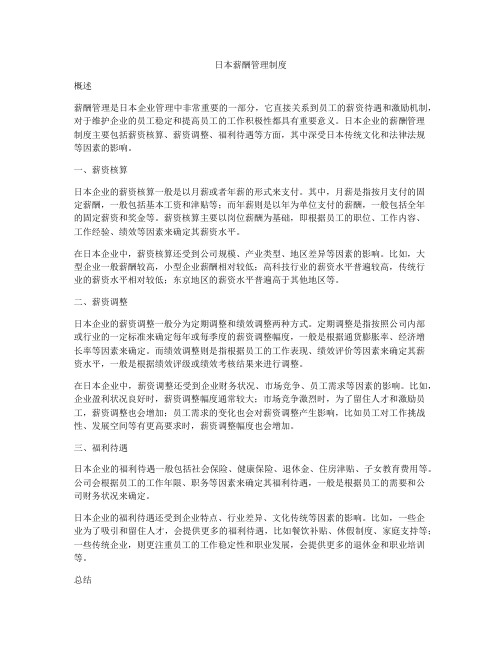
日本薪酬管理制度概述薪酬管理是日本企业管理中非常重要的一部分,它直接关系到员工的薪资待遇和激励机制,对于维护企业的员工稳定和提高员工的工作积极性都具有重要意义。
日本企业的薪酬管理制度主要包括薪资核算、薪资调整、福利待遇等方面,其中深受日本传统文化和法律法规等因素的影响。
一、薪资核算日本企业的薪资核算一般是以月薪或者年薪的形式来支付。
其中,月薪是指按月支付的固定薪酬,一般包括基本工资和津贴等;而年薪则是以年为单位支付的薪酬,一般包括全年的固定薪资和奖金等。
薪资核算主要以岗位薪酬为基础,即根据员工的职位、工作内容、工作经验、绩效等因素来确定其薪资水平。
在日本企业中,薪资核算还受到公司规模、产业类型、地区差异等因素的影响。
比如,大型企业一般薪酬较高,小型企业薪酬相对较低;高科技行业的薪资水平普遍较高,传统行业的薪资水平相对较低;东京地区的薪资水平普遍高于其他地区等。
二、薪资调整日本企业的薪资调整一般分为定期调整和绩效调整两种方式。
定期调整是指按照公司内部或行业的一定标准来确定每年或每季度的薪资调整幅度,一般是根据通货膨胀率、经济增长率等因素来确定。
而绩效调整则是指根据员工的工作表现、绩效评价等因素来确定其薪资水平,一般是根据绩效评级或绩效考核结果来进行调整。
在日本企业中,薪资调整还受到企业财务状况、市场竞争、员工需求等因素的影响。
比如,企业盈利状况良好时,薪资调整幅度通常较大;市场竞争激烈时,为了留住人才和激励员工,薪资调整也会增加;员工需求的变化也会对薪资调整产生影响,比如员工对工作挑战性、发展空间等有更高要求时,薪资调整幅度也会增加。
三、福利待遇日本企业的福利待遇一般包括社会保险、健康保险、退休金、住房津贴、子女教育费用等。
公司会根据员工的工作年限、职务等因素来确定其福利待遇,一般是根据员工的需要和公司财务状况来确定。
日本企业的福利待遇还受到企业特点、行业差异、文化传统等因素的影响。
比如,一些企业为了吸引和留住人才,会提供更多的福利待遇,比如餐饮补贴、休假制度、家庭支持等;一些传统企业,则更注重员工的工作稳定性和职业发展,会提供更多的退休金和职业培训等。
日本儿童福利制度与儿童福利设施
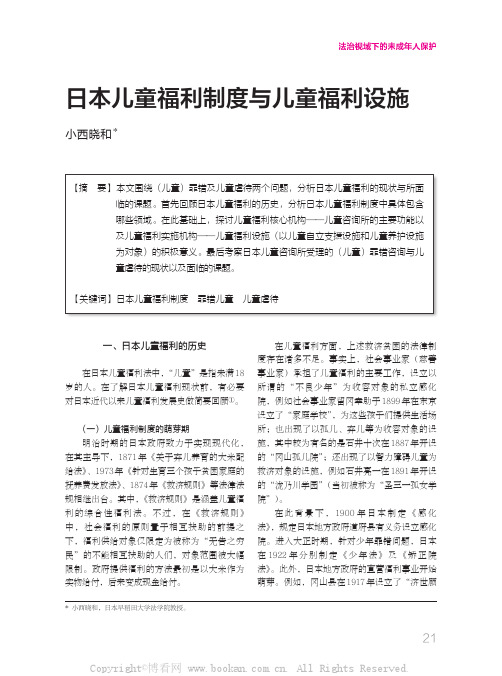
一、日本儿童福利的历史在日本儿童福利法中,“儿童”是指未满18岁的人。
在了解日本儿童福利现状前,有必要对日本近代以来儿童福利发展史做简要回顾①。
(一)儿童福利制度的萌芽期明治时期的日本政府致力于实现现代化,在其主导下,1871年《关于弃儿养育的大米配给法》、1973年《针对生育三个孩子贫困家庭的抚养费发放法》、1874年《救济规则》等法律法规相继出台。
其中,《救济规则》是涵盖儿童福利的综合性福利法。
不过,在《救济规则》中,社会福利的原则置于相互扶助的前提之下,福利供给对象仅限定为被称为“无告之穷民”的不能相互扶助的人们,对象范围被大幅限制。
政府提供福利的方法最初是以大米作为实物给付,后来变成现金给付。
在儿童福利方面,上述救济贫困的法律制度存在诸多不足。
事实上,社会事业家(慈善事业家)承担了儿童福利的主要工作,设立以所谓的“不良少年”为收容对象的私立感化院,例如社会事业家留冈幸助于1899年在东京设立了“家庭学校”,为这些孩子们提供生活场所;也出现了以孤儿、弃儿等为收容对象的设施,其中较为有名的是石井十次在1887年开设的“冈山孤儿院”;还出现了以智力障碍儿童为救济对象的设施,例如石井亮一在1891年开设的“泷乃川学园”(当初被称为“圣三一孤女学院”)。
在此背景下,1900年日本制定《感化法》,规定日本地方政府道府县有义务设立感化院。
进入大正时期,针对少年罪错问题,日本在1922年分别制定《少年法》及《矫正院法》。
此外,日本地方政府的直营福利事业开始萌芽。
例如,冈山县在1917年设立了“济世顾日本儿童福利制度与儿童福利设施小西晓和*【摘要】本文围绕(儿童)罪错及儿童虐待两个问题,分析日本儿童福利的现状与所面临的课题。
首先回顾日本儿童福利的历史,分析日本儿童福利制度中具体包含哪些领域。
在此基础上,探讨儿童福利核心机构——儿童咨询所的主要功能以及儿童福利实施机构——儿童福利设施(以儿童自立支援设施和儿童养护设施为对象)的积极意义。
日本老龄社会福利制度改革的反思与启示
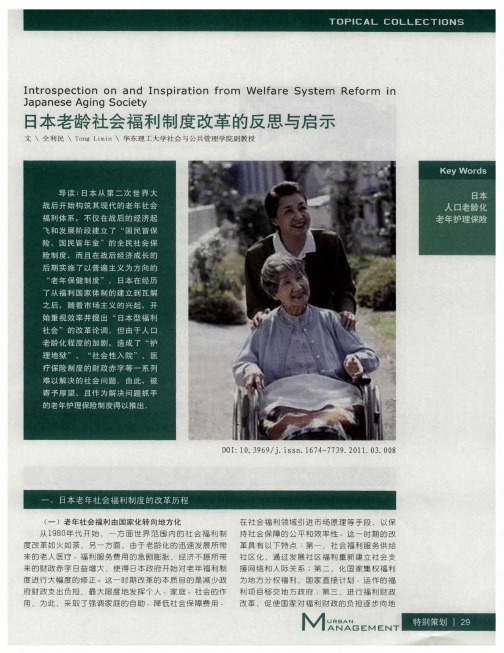
的 社 会 福 利 制 度 , 如 为 满 足 人 们 在 经 济 方 面
的 安 全 需 求 而 建 立 的 社 会 保 障 芾 度 、力 满 足 l J
年 人 的 数 据 , 说 明 老 年 人 的 长 期 护 理 照 料 问题 孰 已 经 存 职 业 安 全 需 求 而 建 立 的 失 业 保 险 觏 度 、为 满 在 只 是 在 量 的 方 面 比过 去 更 加 严 重 了 而 已 ” , 以证 实 自 己 的 笔论 由 以 上 可 看 出 尽 管 人 口 老 龄 化 程 度 进 一 步 加 深 、
其 以 冢 庭 力 基 础 的 老 年 福 利 政 策 , 而 是 如 既 住 地 延 续 其
在 社 会 保 障 制 度 建 立 初 期 的 发 展 模 式 . 为 了经 济 发 展 而 对
家 庭 护 理 照 料 现 状 听 之 任 之 。不 仅 如 此 . 还 进 一 步 削 减 政
费 支 出 特 别 是 抑 制 国 库 的 负 担 比例 : 二 . 以受 益 者 负 第 担 力 原 则 加 大 利 用 者 的 负 担 比 例 ,特 别 是 增 加 老 年 人 的
负 担 比例 : 三 ,推 动 福 利 事 业 的 市 场 化 , 并减 少 政 府 责 第
任 。ቤተ መጻሕፍቲ ባይዱ
( )老 年 社 会 福 利 由私 募 转 向保 险 三 从 1 g 年 代 以 来 的 社 会 保 障 制 度 基 础 结 构 改 革 中 可 9 o
始抛 弃 “ 日本 型 福 利 社 会 ” 论 。与 此 同 时 , 政 府 又 肾目 光 没 有达 到 。
转 向 了 民 间 社 会 并 用 “ 分 发 挥 社 会 活 力 和 竞 争 的 市 场 充 对 此 , 日本 学 者 木 村 武 司 认 为 . 日本 型
世界各国的退休福利制度比较
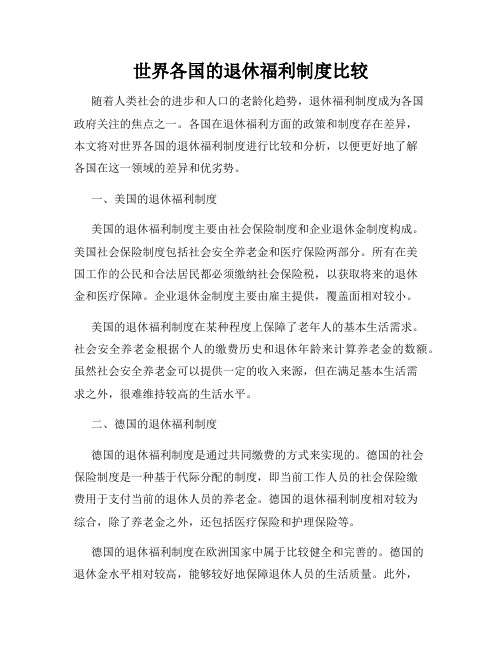
世界各国的退休福利制度比较随着人类社会的进步和人口的老龄化趋势,退休福利制度成为各国政府关注的焦点之一。
各国在退休福利方面的政策和制度存在差异,本文将对世界各国的退休福利制度进行比较和分析,以便更好地了解各国在这一领域的差异和优劣势。
一、美国的退休福利制度美国的退休福利制度主要由社会保险制度和企业退休金制度构成。
美国社会保险制度包括社会安全养老金和医疗保险两部分。
所有在美国工作的公民和合法居民都必须缴纳社会保险税,以获取将来的退休金和医疗保障。
企业退休金制度主要由雇主提供,覆盖面相对较小。
美国的退休福利制度在某种程度上保障了老年人的基本生活需求。
社会安全养老金根据个人的缴费历史和退休年龄来计算养老金的数额。
虽然社会安全养老金可以提供一定的收入来源,但在满足基本生活需求之外,很难维持较高的生活水平。
二、德国的退休福利制度德国的退休福利制度是通过共同缴费的方式来实现的。
德国的社会保险制度是一种基于代际分配的制度,即当前工作人员的社会保险缴费用于支付当前的退休人员的养老金。
德国的退休福利制度相对较为综合,除了养老金之外,还包括医疗保险和护理保险等。
德国的退休福利制度在欧洲国家中属于比较健全和完善的。
德国的退休金水平相对较高,能够较好地保障退休人员的生活质量。
此外,德国的医疗保险和护理保险制度也为退休人员提供了全面的医疗和护理保障。
三、日本的退休福利制度日本的退休福利制度主要由国民年金制度和企业年金制度构成。
国民年金是一种普遍适用于所有居民的退休金制度,覆盖面广泛。
而企业年金制度为企业员工提供额外的养老金福利。
日本的国民年金制度相对较为严格,所有居民(包括外国人)在年满20岁后必须缴纳国民年金。
国民年金的领取条件较为严格,需要满足一定的缴费年限和年龄要求。
此外,由于日本社会的老龄化程度较高,国民年金的支付压力较大,可能无法满足人们的养老需求。
四、中国的退休福利制度中国的退休福利制度是由企业养老保险制度、城乡居民养老保险制度和个人储蓄养老制度构成。
- 1、下载文档前请自行甄别文档内容的完整性,平台不提供额外的编辑、内容补充、找答案等附加服务。
- 2、"仅部分预览"的文档,不可在线预览部分如存在完整性等问题,可反馈申请退款(可完整预览的文档不适用该条件!)。
- 3、如文档侵犯您的权益,请联系客服反馈,我们会尽快为您处理(人工客服工作时间:9:00-18:30)。
New Corporate Pension Schemes Employee Pension Funds
Occupational Pensions
C
The National Pension System
The National Pension System was introduced in 1959 and is mandatory for all residents between 20 and 59 years of age.
Employee Pension Funds
Employer and employee contributions are tax-deductible without limits. Investment income is taxed in principle, but only under rare conditions. However, the tax is frozen until 2009. A portion of benefits is taxed as income; the amount depends on total pension income.
The current old-age dependency ratio stands at 30 and will worsen to 74 in 2050.
During the same period, Japan's population will decrease from 128 million to 102 million. The fertility rate of 1.26 children per woman lies considerably below the rate of 2.1 that is needed to maintain the population.
Child allowances
In Japan, the hospital may not be profitable, social welfare spending accounted for 18.6% of GDP.
Almost every city in Japan is funded public health management center, the local public hospitals and university affiliated hospitals by the government, for the local people to provide comprehensive health management services.
The challenges of ageing in Japan are considerable. For this reason, pension reforms aim to achieve greater system sustainability. The automatic balancing mechanism for public pensions was inspired by reforms in Sweden, but adjusted to the Japanese environment.
The National Pension System
Monthly pension benefits after 40 years of working life and from age 65 onwards, the official retirement age for the National Pension System Shorter contribution periods result in lower benefits. The system receives substantial subsidies of currently one-third of payments from the Japanese government, a share that will be raised to 50% by 2009.
Employee Pension Insurance
The second part of public pension provision is earnings-related. The contribution rate to Employee Pension Insurance is 14.64% of wages, which is equally split between employers and employees. Employees aged 60 and over with 25 years of contributions are entitled to benefits from the Employee Pension Insurance scheme.
ቤተ መጻሕፍቲ ባይዱ
The Kodomo Teate Law is a law introduced in Japan by the Democratic Party of Japan(DPJ) in April 2010. It grants 13,000 yen per month to parents with children up to the age of fifteen.
THANK YOU FOR WATCHING
The Government Pension Investment Fund
It is the largest pension fund worldwide. In 2005, it directly managed assets of around EUR 560 billion (JPY 88 trillion).
The social system welfare in Japan
Pension System Design
In recent years, the Japanese pension system has undergone various reforms in the public and occupational pension pillars. The current system consists of the flat-rate National Pension System and employment-related pensions for public and private sector employees; these two elements combined form the public pension pillar.
Occupational Pensions
Employee Pension Funds and TaxQualified Pension Plans. As these two were considered neither sustainable nor sufficient for retirement income security, defined contribution and defined benefit plans were introduced in 2001 and 2002.
At the same time, Japan's life expectancy is among the highest in the world.
Nevertheless, we expect corporate pension assets to grow only 1% per year until 2015
